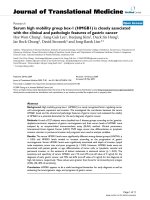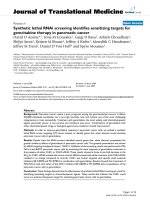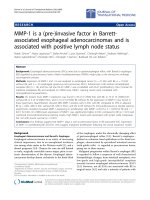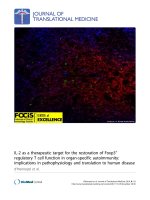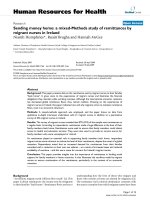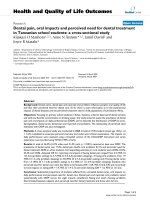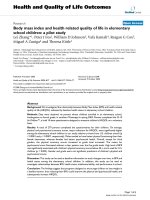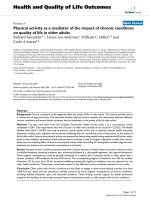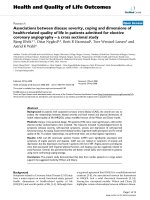báo cáo hóa học:" Endometriosis-associated ovarian cancer: A tenyear cohort study of women living in the Estrie Region of Quebec, Canada" doc
Bạn đang xem bản rút gọn của tài liệu. Xem và tải ngay bản đầy đủ của tài liệu tại đây (267.48 KB, 5 trang )
BRIE F COMM U N I CATIO N Open Access
Endometriosis-associated ovarian cancer: A ten-
year cohort study of women living in the Estrie
Region of Quebec, Canada
Aziz Aris
*
Abstract
Objectives: Endometriosis has been believed to increase the risk of developing ovarian cancer, but recent data
supporting this hypothesis are lacking. The aim of this study was to verify whether the incidence of endometriosis,
ovarian cancer and the both increased during the last 10 years among women living in the Estrie region of
Quebec.
Methods: We collected data of women diagnosed with endometriosis, ovarian cancer or both, between 1997 and
2006, from a population living in the Estrie region of Quebec. We performed this retrospective cross-sectional study
from the CIRESSS (Centre Informatisé de Recherche Évaluative en Services et Soins de Santé) system, the database
of the CHUS (Centre Hospitalier Universitaire of Sherbrooke), Sherbrooke, Canada.
Results: Among the 2854 identified patients, 2521 had endometriosis, 292 patients had ovarian cancer and 41
patients had both ovarian cancer and endometriosis. We showed a constant increase in the number of ovarian
cancer (OC) betwe en 1997 and 2006 (r
2
= 0.557, P = 0.013), which is not the case for endometriosis (ENDO) or
endometriosis-associated ovarian cancer (EAOC). The mean age ± SD was 40.0 ± 9.9 and 53.9 ± 11.4 for patients
having ENDO and OC, respectively. Mean age of women with EAOC was 48.3 ± 10.8, suggesting an early onset of
ovarian cancer in women having endometriosis of about 5.5 years average, P = 0.003. Women with ENDO were at
increased risk for developing OC (Rate Ratio [RR] = 1.6; 95% Confidence Interval [CI] = 1.12-2.09). Pathological
analyses showed the predominance of endometrioid type (24.4%) and clear-cell type (21.9%) types in EAOC
compared to OC, P = 0.0070 and 0.0029, respectively. However, the serous type is the most widespread in OC
(44.5%) in comparison to EAOC (19.51%), P = 0.0023.
Conclusion: Our findings highlight that the number of cases of ovarian cancer is constantly increasing in the last
ten years and that endometriosis represents a serious risk factor which accelerates its apparition by about 5.5 years.
Background
According to Ovarian Cancer Canada citing Statistics
from the National Ovarian Cancer Survey: Perspectives
of Canadian Women and Health Care Professionals
(1999) [1]. Ovarian cancer (OC) affects about 1 in 70
Canadian women. About 23 00 new cases of ovarian can-
cer are found in women in Canada each year. About
1600 Canadian women die each year of this disease, mak-
ing it the fifth r anking cause of cancer deaths. Six out of
ten women di agno sed with ovarian cancer in Canada are
50 to 79 years of age [1]. The high mortality rate arises
mainly because the disease is asymptomatic in its initial
stages, making its early detection difficult [2]. At the time
of diagnosis, dissemination has occurred in more than
70% of cases, at which point the 5-year survival rate is
less than 20%. Ninety percent of all ovarian ca ncers are
epithelial in origin, and are classified according to their
cell types (serou s, mucinous, endome trioid, clear cell and
undifferentiated or mixed histology) [2].
Different etiological factors have been implicated in
ovarian cancer types although, at present, little is known
about the molecular events involved in their individual
development. Some types such as clear-cell and endo-
metrioid have been shown associated with the benign
* Correspondence:
Department of Obstetrics and Gynecology, Sherbrooke University Hospital
Centre, 3001, 12e Avenue Nord, Sherbrooke, Quebec, J1H 5N4 Canada
Aris Journal of Ovarian Research 2010, 3:2
/>© 2010 Aris; licensee BioMed Central Ltd. This is an Open Access articl e distributed under the terms of the Creative Commons
Attribution License ( censes/by/2.0), which permits unrestricted use, distribution, and reprodu ction in
any medium, provided the original work is properly cited.
disease, endometriosis [3]. This disease is a complex
genetic trait which af fects up to 10% of wom en in their
reproductive years [4]. It causes pelvic pain, severe dys-
menorrhea (painful periods) and subfertility [5]. The dis-
ease is defined by the presence of endometrial-like
epithelium and stroma in the extra-uterine sites, most
commonly the ovaries and peritoneum. The main patho-
logical processes assoc iated with endometriosis are peri-
toneal inflammation and fibrosis, and the formation of
adhesions and endometriomas (benign ovarian cysts).
Circumstantial evidence that endometriosis is an endo-
metriosis-associated ovarian cancer precursor has been
accumulating over many years.
Although many of the risk fa ctors associated with both
diseases are similar, including earlier menarche, more
regular periods, shorter cycle length and lower parity,
end ometriosis itself may be a risk factor for ovarian can-
cer. However, the results of observational studies of the
association between these two diseases are inconsistent.
Some studies showed an increased risk for ovarian cancer
[6-10], while other studies did not confirm such an asso-
ciation [11-13]. The aim of this study was to clarify
further the rela tionship betwe en ovarian cancer and
endometriosis in the Estrie region of Quebec, Canada.
Materials and methods
Located at the CHUS (Sherbrooke University Hospital
Centre), the CIRESSS (Centre Informatisé de Recherche
Évaluative en Services et Soins de Santé) system man-
ages clinical and pathological data obtained from the
computerized patients’ records of all residents in the
Estrie region of Quebec. It covers 300 383 individuals,
and it is principally based on clinical and pathological
reports. Cancer incidence was coded according to the
second edition of the International Classification of Dis-
eases for Oncology (ICD-O-2). Endometriosis was coded
according to the International Classifi cation of Diseases,
Ninth Revision, Clinical Mod ification [ICD-9-CM],
codes 617.00-617.99.
This retrospective study is based on women with ovar-
ian cancer, who were identified from the archive of the
CIRESSS Registry during a 10-year period (1997-2006).
A total of 2521 female patients with endometriosis were
present, as well as 292 with ovarian cancer. A total of
41 women had ovarian cancer and endometriosis. Codes
for ovarian cancer and endometriosis, respectively, were
extracted from the archive, and the demographical and
pathological data were analyzed. We reviewed medical
and pathological reports to confirm the presence of
ovarian cancer and/or endometriosis. Histological types
of ovarian cancer were obtained for ovarian cancer asso-
ciated or not associated with endometriosis.
The study was approved by the CHUS Ethics Human
Research Committee on Clinical Research, the Research
Ethics Board of the CHUS, and received the number of
approbation # 07-054.
Statistical Analysis
Analysis of variance (ANOVA) was used to evaluate if
there were significant differences for age of patients
between the studied groups. To co mpare the proportion
of histological type between the groups with ovarian
cancer or endometriosis-associated ovarian cancer, the
test of Chi-Square was used or Fisher Exact test when
frequency are smaller than 5.
It was interesting to study if the number of subjects
increased in each of the groups by years. A simple linear
regression was thus realized to compare the percentage
of subjects by years with regard to the number of total
subject s over the period studied according to years. One
regression was realized by groups studied.
Analyses were realized with the software SPSS version
14.0 and the StatXact version 6.0. A value of p < 0.05
was considered as significant for every statistical
analysis.
Results
As shown in Table 1, among the 2854 identified
patients, 2521 had endometriosis (ENDO), 292 patients
had ovarian cancer (OC) and 41 patients had the both,
i.e. endometriosis-associated ovarian cancer (EAOC).
Using simple linear regression analyses (Figure 1), we
showed that there is a constant increase in the number
of OC between 1997 and 2006 (r
2
= 0.557, P = 0.013),
whereas this increase has not been demonstrated in
endometriosis alone (r
2
=0.046,P=0.550)orendome-
triosis-associated ovarian cancer (r
2
= 0.263, P = 0.123).
Afteradjustingforage,numberofpregnancies,family
history of ovarian cancer, race, oral contraceptive use,
tubal ligation, hysterectomy and breastfeeding; women
with endometriosis were at increased risk for developing
ovarian cancer (Rate Ratio [ RR] = 1.6; 95% Confidence
Interval [CI] = 1.12-2.09). According to census data from
2001 of the Estrie Region, prevalence was 10.7% and
0.11% for ENDO and EAOC, res pectively; ENDO among
Table 1 Age at diagnosis of endometriosis (ENDO),
ovarian cancer (OC) and endometriosis-associated
ovarian cancer (EAOC) groups
N Age SD
ENDO 2521 40.0† 9.9
OC 292 53.8† 11.4
EAOC 41 48.3† 10.8
Total 2854 41.6 10.9
†Significant difference between groups in the age at endometriosis or ovarian
cancer diagnosis (P < 0.0001). After Tukey adjustment, mean difference (± SE)
of age was 8.2 ± 1.6, P < 0.0001 between EAOC and ENDO; -5.5 ± 1.7, P =
0.003 between EAOC and OC; and -13.8 ± 0.6, P < 0.0001 between ENDO and
OC.
Aris Journal of Ovarian Research 2010, 3:2
/>Page 2 of 5
OC cases was 14% and incidence of OC was 24% (Table
2). Of note, prevalen ce and incidence were compared
between our results and literature [14-16] (Table 2).
The mean age ± SD was 40.0 ± 9.9 and 53.9 ± 11.4 for
patients having endometriosis or ovarian cancer (OC),
respectively. Mean age of women with endometriosis-
associated ovarian cancer (EAOC) was 48.3 ± 10.8
(Table 1). Furthermore, data after Tukey adjustment
showed that mean (± SE) difference of age at ovarian
cancer diagnosis was 5.5 ± 1.7 between EAOC and OC,
P = 0.003, suggesting an early onset of ovarian cancer in
women having endometriosis of about 5.5 years averag e
(Table 1). The mean difference of age was 8.2 ± 1.6 late
in EAOC compared to ENDO, P < 0.0001; and 13.8 ±
0.6 earlier in ENDO compared to OC, P < 0.0001
(Table 1).
Pathological analyses, as summarized in Table 3,
showed that 2 types of ovarian cancer predominate in
EAOC in comparison to OC: endometrioid type (24.4%,
P = 0.007) and clear-cell type (21.9%, P = 0.003),
whereas serous type (44.5%) was predominant in OC
compared to EAOC, P = 0.002. Difference in percentag e
between endometrioid, clear-cell and serous types in the
EAOC group was not statistically significant. On the
other hand, all other types (i.e. epidermoid, mixed, etc)
represent 36.6% in EAOC and 38.4% in OC, without sta-
tistically significance.
Discussion
Ovarian cancer belongs to the most lethal class of gyne-
cological malignancies and remains the fifth most com-
mon cause of cancer-related deaths among women [17].
The overall 5-year survival rate remains poor, despite sig-
nificant improvements in surgical treatment and che-
motherapy. The first interesting results in our study were
the constant increase of the number ovarian cancer since
1997 to 2006. This increase is not supported by literature
[16,18] and should attract attention. Other studies should
confirm if this increase is a geographical ly widespread or
localized phenomenon. Further investigations should also
be undertaken to find out more about the causes that
have contributed to this increase.
The second findings of our study showed that the
cohort of endometriosis women had an increased risk
of ovarian cancer of 1.6 (95% CI 1.12-2.09). These data
are consistent with other studies highlighting the
increased risk of ovarian cancer in endometriosis
patients [6,7,18]. Since endometriosis is a common
benign gynecological disorder affecting 10% of women
during their reproductive years [19], with a reported
prevalence going as high as 15-25% in some studies
[18,20], any association with OC is concerning. Preva-
lence and incidence were obtained using census data
from 2001 of the Estrie Region (Census of Canada,
2001). Observed results are consistent with literat ure.
However, we noticed an increased incidence of OC in
our region compared to data from the US National
Figure 1 Annual variation of the percentage of endome triosis
(ENDO), endometriosis-associated ovarian cancer (EAOC) and
ovarian cancer (OC) cases between 1997 and 2006. Using simple
linear regression analysis, there was no annual significant increase of
cases of endometriosis (ENDO: asterisk) and endometriosis-
associated ovarian cancer (EAOC: white square),r
2
= 0.046, P =
0.550 and r
2
= 0.263, P = 0.123; respectively. However, the
percentage of cases of ovarian cancer (OC: black triangle) was
increased between 1997 and 2006, r
2
= 0.557, P = 0.013.
Table 2 Prevalence and incidence of endometriosis (ENDO), ovarian cancer (OC) and endometriosis-associated ovarian
cancer (EAOC), according to our data and literature
Our data Literature References
Prevalence of ENDO 10.7% 10% Wheeler et al. 1989
Prevalence of EAOC 0.11% 0.09% Wheeler et al. 1989; Van Gorp et al. 2004
Risk of malignant transformation in ENDO 1.63% 0.7-4.5% Kobayashi et al. 2009; Van Gorp et al. 2004
ENDO among OC cases 14.0% - -
Incidence of OC 24.2† 13.2 Kobayashi et al. 2009
†Incidence of OC = 24.2/100 000
Aris Journal of Ovarian Research 2010, 3:2
/>Page 3 of 5
Cancer Institute for the same period. Also, it is known
that prevalence of ENDO (in ou r region as in literature)
is probabl y an under-estimation since an unknown pro-
portion of women suffering of ENDO do not consult
for their symptoms.
On the other hand, the age at ovarian cancer diagno-
sis, in our study, is of about 54 years and this is consis-
tent with previous studies [21,22]. It is interesting to
note that the mean age at diagnosis of ovarian cancer in
endometriosis patients is of 48 years, therefore earlier
about 5.5 years average. This difference in the age at
diagnosis might be explained by the fact that women
with ENDO consult earlier owing to associated symp-
toms. However, the hypothesis of an earlier develop-
ment of the OC in women with ENDO cannot be ruled
out. The earlier manifestation of OC has serious conse-
quences, since survival in cases of ovarian cancer rarely
exceeds 5 years.
Our results showed that 3 types of ovarian cancer are
more common in patients with endometriosis compared
to those without: endometrioid type (24.4%) and clear-
cell type (21.9%). Our findings are consistent with other
studies supporting the predominance of endometrioid
and clear-cell types of ovarian cancer-associated endo-
metriosis [18,23,24].
Conclusion
Our study reveals that the number of cases of OC has
increased steadily over the last decade in ou r region and
that endometriosis represents a risk factor associated
with an earlier time of diagnosis of about 5.5 years in
relation to its apparition. On the other hand, despite the
pathophysio logical and epidemiological evidence linking
endometriosis with ovarian cancer, it is still unclear
whether endometriosis is a precursor t o EAOC, or
whether there is an indi rect link involving common
environmental, immunological, hormonal or genetic fac-
tors. Further investigations are needed to provide
answers to these pertinent questions.
List of abbreviations
ENDO: endometriosis; OC: ovarian cancer; EAOC:
endometriosis-associated ovarian cancer; RR: rate ratio;
CI: confidence interval.
Acknowledgements
We thank Hassan Diab (CIRESSS), Nathalie Carrier and Krystel Paris for their
assistance with data management and statistical analysis.
Authors’ contributions
AA: Professor, responsible for the project. He was involved in all steps of the
work (i.e. conception, design, analysis and interpretation of data, and
drafting the manuscript).
Competing interests
The author declares that they have no competing interests.
Received: 25 August 2009
Accepted: 19 January 2010 Published: 19 January 2010
References
1. National Cancer Institute of Canada: Annual report. Toronto 1999.
2. Ozols RF, Bookman MA, Connolly DC, Daly MB, Godwin AK, Schilder RJ,
Xu X, Hamilton TC: Focus on epithelial ovarian cancer. Cancer Cell 2004,
5:19-24.
3. Bell DA: Origins and molecular pathology of ovarian cancer. Mod Pathol
2005, 18(Suppl 2):S19-32.
4. Barlow DH, Kennedy S: Endometriosis: new genetic approaches and
therapy. Annu Rev Med 2005, 56:345-56.
5. Berkley KJ, Rapkin AJ, Papka RE: The pains of endometriosis. Science 2005,
308:1587-9.
6. Ness RB, Grisso JA, Cottreau C, Klapper J, Vergona R, Wheeler JE, Morgan M,
Schlesselman JJ: Factors related to inflammation of the ovarian
epithelium and risk of ovarian cancer. Epidemiology 2000, 11:111-7.
7. Brinton LA, Gridley G, Persson I, Baron J, Bergqvist A: Cancer risk after a
hospital discharge diagnosis of endometriosis. Am J Obstet Gynecol 1997,
176:572-9.
8. Ness RB, Cramer DW, Goodman MT, Kjaer SK, Mallin K, Mosgaard BJ,
Purdie DM, Risch HA, Vergona R, Wu AH: Infertility, fertility drugs, and
ovarian cancer: a pooled analysis of case-control studies. Am J Epidemiol
2002, 155:217-24.
9. Cahill DJ, Hull MG: Pituitary-ovarian dysfunction and endometriosis. Hum
Reprod Update 2000, 6:56-66.
10. Modugno F, Ness RB, Allen GO, Schildkraut JM, Davis FG, Goodman MT:
Oral contraceptive use, reproductive history, and risk of epithelial
ovarian cancer in women with and without endometriosis. Am J Obstet
Gynecol 2004, 191:733-40.
11. Rossing MA, Daling JR, Weiss NS, Moore DE, Self SG: Ovarian tumors in a
cohort of infertile women. N Engl J Med 1994, 331:771-6.
12. Ron E, Lunenfeld B, Menczer J, Blumstein T, Katz L, Oelsner G, Serr D:
Cancer incidence in a cohort of infertile women. Am J Epidemiol 1987,
125:780-90.
13. Venn A, Watson L, Lumley J, Giles G, King C, Healy D: Breast and ovarian
cancer incidence after infertility and in vitro fertilisation. Lancet 1995,
346:995-1000.
14. Wheeler JM: Epidemiology of endometriosis-associated infertility. J
Reprod Med 1989, 34:41-6.
15. Van Gorp T, Amant F, Neven P, Vergote I, Moerman P: Endometriosis and
the development of malignant tumours of the pelvis. A review of
literature. Best Pract Res Clin Obstet Gynaecol 2004,
18:349-71.
16. Kobayashi H: Ovarian cancer in endometriosis: epidemiology, natural
history, and clinical diagnosis. Int J Clin Oncol 2009, 14:378-82.
17. Yoshikawa H, Jimbo H, Okada S, Matsumoto K, Onda T, Yasugi T, Taketani Y:
Prevalence of endometriosis in ovarian cancer. Gynecol Obstet Invest 2000,
50(Suppl 1):11-7.
18. Nezhat F, Datta MS, Hanson V, Pejovic T, Nezhat C: The relationship of
endometriosis and ovarian malignancy: a review. Fertil Steril 2008,
90:1559-70.
Table 3 Groups of endometriosis-associated ovarian
cancer (EAOC) and ovarian cancer (OC), according to
histological types
EAOC OC P value
N%N%
Clear-cell type 9 21.95 22 7.53 0.0029*
Endometrioid
type
10 24.39 29 9.93 0.0070*
Mucinous type 2 4.88 6 2.05 0.2571
Serous type 8 19.51 130 44.52 0.0023*
Other types 15 36.58 112 38.36 0.8270
Comparisons wer e performed between endometriosis-associated ovarian
cancer (EAOC) and ovarian cancer (OC).
* P < 0.01 for clear-cell, endometrioid, and serous types .
Aris Journal of Ovarian Research 2010, 3:2
/>Page 4 of 5
19. Cramer DW, Missmer SA: The epidemiology of endometriosis. Ann N Y
Acad Sci 2002, 955:11-22, discussion 34-6, 396-406.
20. Olive DL, Schwartz LB: Endometriosis. N Engl J Med 1993, 328:1759-69.
21. Borgfeldt C, Andolf E: Cancer risk after hospital discharge diagnosis of
benign ovarian cysts and endometriosis. Acta Obstet Gynecol Scand 2004,
83:395-400.
22. Kobayashi H, Sumimoto K, Moniwa N, Imai M, Takakura K, Kuromaki T,
Morioka E, Arisawa K, Terao T: Risk of developing ovarian cancer among
women with ovarian endometrioma: a cohort study in Shizuoka, Japan.
Int J Gynecol Cancer 2007, 17:37-43.
23. Moll UM, Chumas JC, Chalas E, Mann WJ: Ovarian carcinoma arising in
atypical endometriosis. Obstet Gynecol 1990, 75:537-9.
24. Deligdisch L, Penault-Llorca F, Schlosshauer P, Altchek A, Peiretti M,
Nezhat F: Stage I ovarian carcinoma: different clinical pathologic
patterns. Fertil Steril 2007, 88:906-10.
doi:10.1186/1757-2215-3-2
Cite this article as: Aris: Endometriosis-associated ovarian cancer: A ten-
year cohort study of women living in the Estrie Region of Quebec,
Canada. Journal of Ovarian Research 2010 3:2.
Publish with Bio Med Central and every
scientist can read your work free of charge
"BioMed Central will be the most significant development for
disseminating the results of biomedical research in our lifetime."
Sir Paul Nurse, Cancer Research UK
Your research papers will be:
available free of charge to the entire biomedical community
peer reviewed and published immediately upon acceptance
cited in PubMed and archived on PubMed Central
yours — you keep the copyright
Submit your manuscript here:
/>BioMedcentral
Aris Journal of Ovarian Research 2010, 3:2
/>Page 5 of 5
